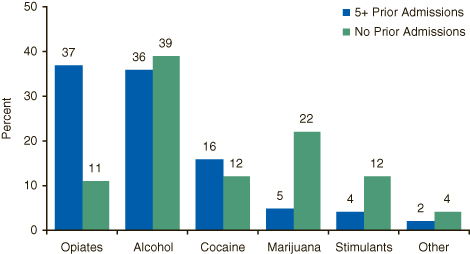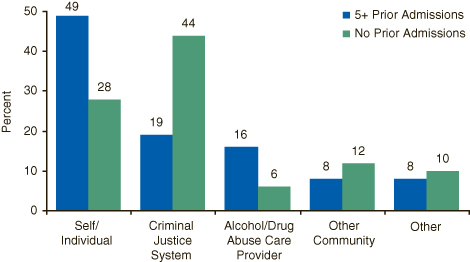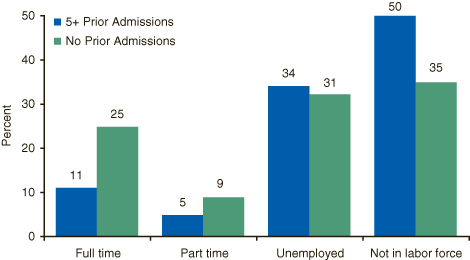
 |
| June 28, 2007 |
|
Substance abuse treatment clients with five or more prior treatment episodes were more likely than first-time admissions to report opiates as the primary substance of abuse3 (37 vs. 11 percent), while first-time admissions were more likely to report marijuana (22 vs. 5 percent) or stimulants (12 vs. 4 percent) (Figure 1). Over one third of both first-time admissions and those with five or more prior admissions reported alcohol as the primary substance of abuse (39 and 36 percent, respectively).
 |
| 5+ Prior Admissions |
No Prior Admissions |
|
|---|---|---|
| Opiates | 37% | 11% |
| Alcohol | 36% | 39% |
| Cocaine | 16% | 12% |
| Marijuana | 5% | 22% |
| Stimulants | 4% | 12% |
| Other | 2% | 4% |
| Source: 2005 SAMHSA Treatment Episode Data Set (TEDS). |
Clients who were admitted with five or more prior substance abuse treatment episodes reported more frequent use of the primary substance of abuse than first-time admissions. About 61 percent of admissions with five or more prior treatment episodes reported daily use compared to 33 percent of first-time admissions. First-time admissions were correspondingly more likely than admissions with five or more prior treatment episodes to report no use in the past month (29 vs. 19 percent) or intermediate frequency of use (i.e., use in the past month but not on a daily basis) (38 vs. 20 percent).
Clients with five or more prior treatment episodes who were admitted to substance abuse treatment showed patterns of referrals to treatment and service settings4 that were distinctly different from first-time admissions. Clients with five or more prior treatment episodes were nearly twice as likely as first-time admissions to be self or individual referrals (i.e., referrals to treatment by the client or another individual) (49 vs. 28 percent), and less than half as likely to be referred by the criminal justice system (19 vs. 44 percent) (Figure 2).
 |
| 5+ Prior Admissions |
No Prior Admissions |
|
|---|---|---|
| Self/Individual | 49% | 28% |
| Criminal Justice System | 19% | 44% |
| Alcohol/Drug Abuse Care Provider | 16% | 6% |
| Other Community | 8% | 12% |
| Other | 8% | 10% |
| Source: 2005 SAMHSA Treatment Episode Data Set (TEDS). |
Substance abuse treatment admissions with five or more treatment episodes were more likely than first-time admissions to be admitted to detoxification (34 vs. 15 percent) or to residential/rehabilitation service settings (19 vs. 15 percent); they were correspondingly less likely to be admitted to ambulatory treatment settings (47 vs. 70 percent).
Although there were no notable gender or racial/ethnic differences between first-time admissions and admissions with five or more prior substance abuse treatment episodes, there were distinct differences by other admissions characteristics.
Substance abuse treatment admissions with five or more prior treatment episodes were more likely than first-time admissions to face a variety of socioeconomic or other challenges. For example, nearly one quarter of admissions with five or more prior treatment episodes were homeless (24 percent) in contrast to less than one tenth of first-time admissions (8 percent).5 Admissions with five or more prior substance abuse treatment episodes were also more likely to report co-occurring psychiatric and substance abuse disorders (29 vs. 17 percent).6
Clients with five or more prior treatment episodes who were admitted to substance abuse treatment were considerably more likely than first-time admissions to be classified as "not in the labor force"7 (50 vs. 35 percent), and less likely to be employed full time (11 vs. 25 percent) (Figure 3). Differences in other employment categories were less pronounced; admissions with five or more prior admissions were less likely than first-time admissions to be employed part time and more likely to be unemployed.
Predictably, clients with five or more prior substance abuse treatment episodes were older, on average, than first-time admissions (38 vs. 32 years). Admissions with five or more prior treatment admissions were more likely than first-time admissions to be 35 to 49 years old (51 vs. 32 percent) or aged 50 or older (13 vs. 8 percent). By contrast, such admissions were less likely than first-time admissions to be younger than 18 (1 vs. 12 percent) or 18 to 25 years old (13 vs. 26 percent). The two admission groups were equally likely to be 26 to 34 years old (22 percent each).
 |
| 5+ Prior Admissions |
No Prior Admissions |
|
|---|---|---|
| Full time | 11% | 25% |
| Part time | 5% | 9% |
| Unemployed | 34% | 31% |
| Not in labor force | 50% | 35% |
| Source: 2005 SAMHSA Treatment Episode Data Set (TEDS). |
|
The Drug and Alcohol Services Information System (DASIS) is an integrated data system maintained by the Office of Applied Studies, Substance Abuse and Mental Health Services Administration (SAMHSA). One component of DASIS is the Treatment Episode Data Set (TEDS). TEDS is a compilation of data on the demographic characteristics and substance abuse problems of those admitted for substance abuse treatment. The information comes primarily from facilities that receive some public funding. Information on treatment admissions is routinely collected by State administrative systems and then submitted to SAMHSA in a standard format. TEDS records represent admissions rather than individuals, as a person may be admitted to treatment more than once. State admission data are reported to TEDS by the Single State Agencies (SSAs) for substance abuse treatment. There are significant differences among State data collection systems. Sources of State variation include completeness of reporting, facilities reporting TEDS data, clients included, and treatment resources available. See the annual TEDS reports for details. Approximately 1.8 million records are included in TEDS each year. Access the latest TEDS reports at: |
| The DASIS Report is published periodically by the Office of Applied Studies, Substance Abuse and Mental Health Services Administration (SAMHSA). All material appearing in this report is in the public domain and may be reproduced or copied without permission from SAMHSA. Additional copies of this report or other reports from the Office of Applied Studies are available on-line: http://www.oas.samhsa.gov. Citation of the source is appreciated. For questions about this report please e-mail: shortreports@samhsa.hhs.gov. |
|
This page was last updated on July 11, 2008. |
|
SAMHSA, an agency in the Department of Health and Human Services, is the Federal Government's lead agency for improving the quality and availability of substance abuse prevention, addiction treatment, and mental health services in the United States. 
* PDF formatted files require that Adobe Acrobat Reader® program is installed on your computer. Click here to download this FREE software now from Adobe. |